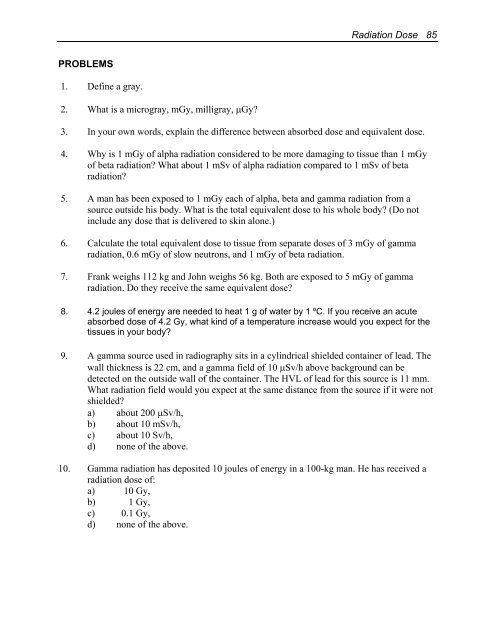CHAPTER 3 RADIATION DOSE
CHAPTER 3 RADIATION DOSE
CHAPTER 3 RADIATION DOSE
Create successful ePaper yourself
Turn your PDF publications into a flip-book with our unique Google optimized e-Paper software.
Radiation Dose 85PROBLEMS1. Define a gray.2. What is a microgray, mGy, milligray, µGy?3. In your own words, explain the difference between absorbed dose and equivalent dose.4. Why is 1 mGy of alpha radiation considered to be more damaging to tissue than 1 mGyof beta radiation? What about 1 mSv of alpha radiation compared to 1 mSv of betaradiation?5. A man has been exposed to 1 mGy each of alpha, beta and gamma radiation from asource outside his body. What is the total equivalent dose to his whole body? (Do notinclude any dose that is delivered to skin alone.)6. Calculate the total equivalent dose to tissue from separate doses of 3 mGy of gammaradiation, 0.6 mGy of slow neutrons, and 1 mGy of beta radiation.7. Frank weighs 112 kg and John weighs 56 kg. Both are exposed to 5 mGy of gammaradiation. Do they receive the same equivalent dose?8. 4.2 joules of energy are needed to heat 1 g of water by 1 ºC. If you receive an acuteabsorbed dose of 4.2 Gy, what kind of a temperature increase would you expect for thetissues in your body?9. A gamma source used in radiography sits in a cylindrical shielded container of lead. Thewall thickness is 22 cm, and a gamma field of 10 µSv/h above background can bedetected on the outside wall of the container. The HVL of lead for this source is 11 mm.What radiation field would you expect at the same distance from the source if it were notshielded?a) about 200 µSv/h,b) about 10 mSv/h,c) about 10 Sv/h,d) none of the above.10. Gamma radiation has deposited 10 joules of energy in a 100-kg man. He has received aradiation dose of:a) 10 Gy,b) 1 Gy,c) 0.1 Gy,d) none of the above.
















